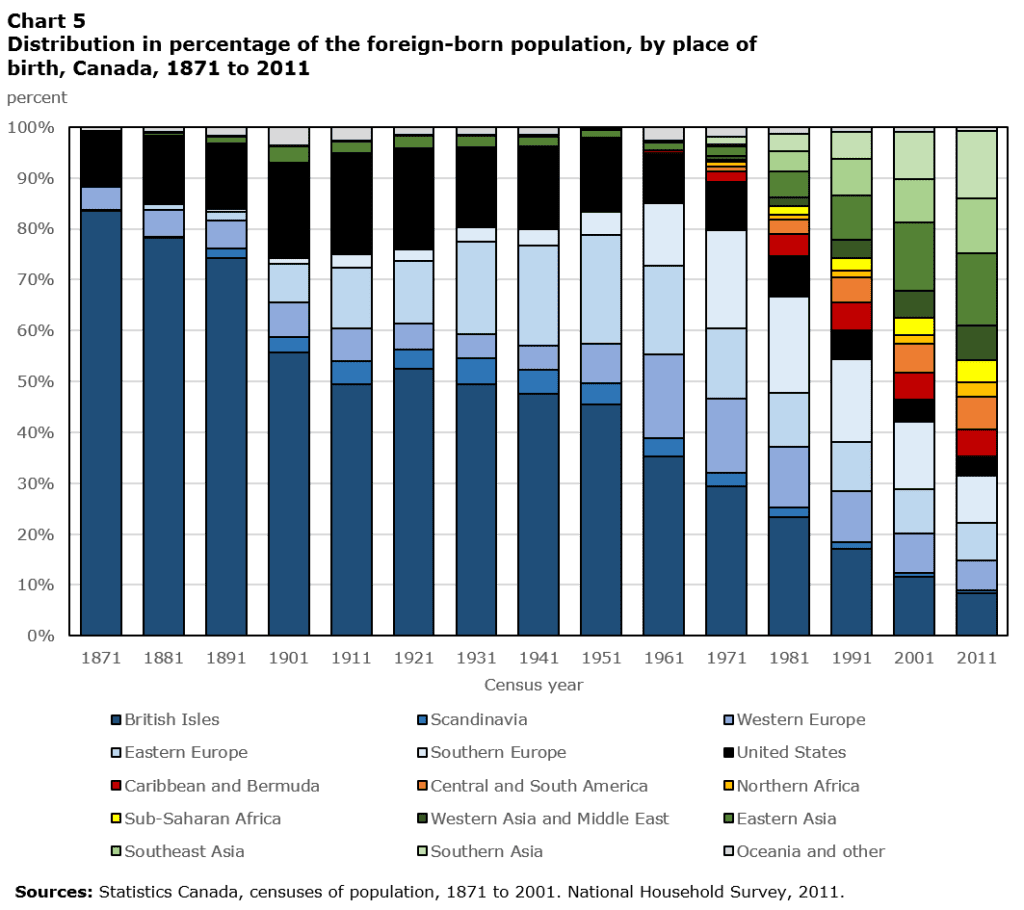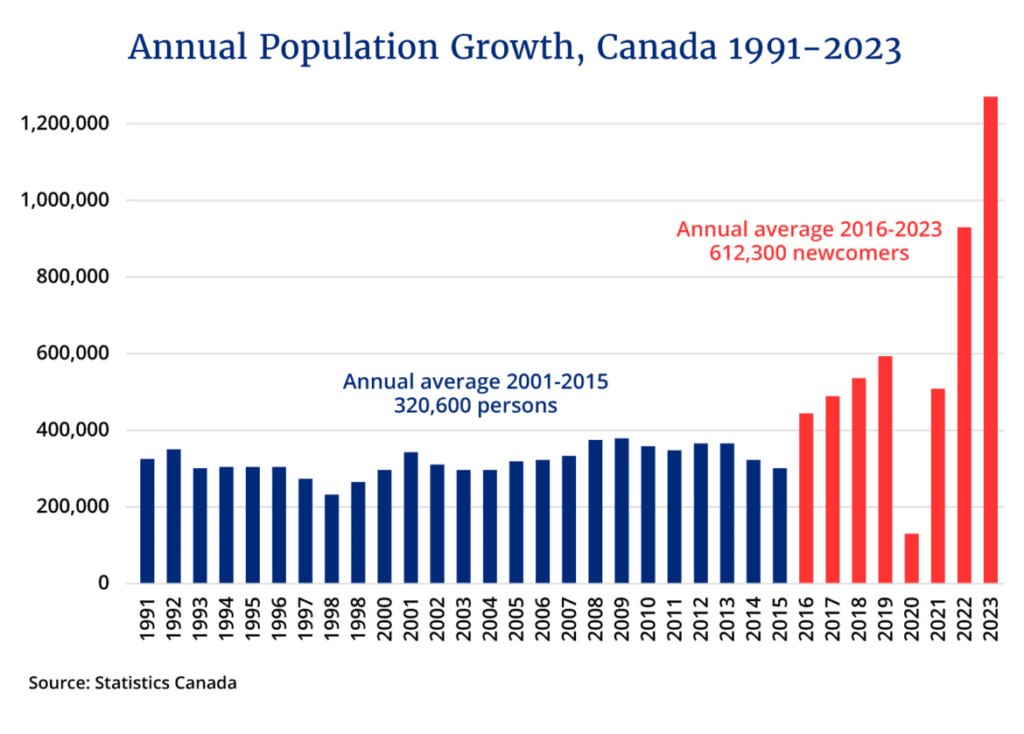Editor’s note: This article was originally published on Population Institute Canada’s website (populationinstitutecanada.ca) on October 31st, 2024. It is republished on Dominion Review with permission of the author.
In 2001, I attended some sessions at a demographic conference in Ottawa. I was astonished when a speaker from Statistics Canada said that immigration had essentially no impact on the Canadian age structure. Even back then, following a decade of high annual immigration initiated in 1990 as a government policy by Brian Mulroney’s immigration minister Barbara McDougall, immigration was being touted as a solution to an aging population.
Mulroney’s Progressive Conservative government fell in 1993, but every government, Liberal or Conservative, that succeeded it continued McDougall’s policy of high immigration regardless of economic conditions. And the “aging population” shibboleth became an integral part of the narrative used to justify this policy as being in the interest of Canadians.
But the argument that high immigration could be a “solution” to a low birth rate (based on the Ponzi-scheme economic paradigm of continuous growth) was never supported by any actual data. Unfortunately, reality does not stand in the way of those profiting from mass migration.
The studies all agree: Immigration cannot rejuvenate Canada
Demographer Rod Beaujot, a professor in the Sociology Department at Western University, has written a number of discussion papers on the impact of immigration in Canada. In a 2003 paper, he argued that immigration could not prevent an increase in the population aged 65 and over as a ratio to the population aged 20 to 64.
In 2006, the C.D. Howe Institute published a study called “No elixir of youth: immigration cannot keep Canada young.” It concluded that immigration could do little to alleviate the likely consequences of aging on Canada’s age structure and government finances. In order to maintain the current dependency ratio, Canada would have to vastly increase immigration and by 2050 would be taking in 7 million immigrants per year and our population would be 65 million.
The dependency ratio is the number of workers (15- to 64-year-olds) for every person either over 65 or under 14 years of age. Of course, many seniors are healthy, productive and independent, and some are still working. The definition of the dependency ratio may need some updating.
In 2007, Shirley Loh (Demography Division at Statistics Canada) and M.V. George (Sociology Dept., University of Alberta, Edmonton) published an article called, “Projected population size and age structure for Canada and provinces: with and without international immigration.” It found that while immigration was making an increasingly significant contribution to the growth of the Canadian population, it had not had and was not projected to have a major impact on Canada’s age structure or on the dependency ratio.
Time has revealed the accuracy of those forecasts. Thirty-four years of consistently high immigration have not had much of an impact on the age structure of Canada’s population.
Jason Kenney’s consultation document of 2012

In 2012, when Jason Kenney was immigration minister under Stephen Harper, Citizenship and Immigration Canada (CIC) published its findings on consultations conducted during the previous year with “stakeholders” and the public. The primary “stakeholders” in these consultations were business interests and organizations serving immigrants. Members of the public were not considered stakeholders, despite the major impact that immigration had on their country.
While stakeholders were invited to attend several cross-country round table meetings in addition to online consultations, the only input available to the public was online. Not surprisingly, stakeholders and individuals differed in their responses. The majority of stakeholders wanted to increase or maintain the immigration level at 250,000, while almost half of the individuals who responded wanted to reduce it. Also not surprisingly, the document reflected the government’s assumption that immigration is essential to Canada’s prosperity.
Nevertheless, it is clear from the document that policymakers knew that immigration did not impact the age structure. On page 49 of the 94-page document, it is stated that, in 2009-2010, the number of births exceeded the number of deaths by 134,000, while net international migration (inflows and outflows of permanent and temporary migration and of Canadian-born individuals) contributed about 255,000 individuals to the population and accounted for about two-thirds of the growth. This is followed by the passage below:
“That being said, research underscores that immigration is not a viable remedy for population aging. A 2009 study [sic, study was in 2006] by the C.D. Howe Institute concludes that improbably huge increases in immigration (i.e. from the current 0.8% to nearly 4% of the population) in the short term would be required to stabilize Canada’s current old-age dependency ratio.”
The document acknowledges that “the number of retirements from the labour force is increasing, currently reflecting the “bulge” of aging baby boomers” (p. 49). Would that bulge then not simply be a transient phenomenon as the super-sized cohort of boomers retire and pass on, much like a huge bolus of food passes through the body of a snake? In many ways, this “baby boom” is a global phenomenon that will play out at different times in different regions depending on how fast fertility rates fall, but in all cases reflecting the spectacular increase in the global population during the 20th century.
Why then would the government continue to implement a policy of mass immigration? The answer can be summarized in this excerpt (p. 49):
“As natural population growth in Canada slows, with fertility rates below replacement levels, immigration will be an increasingly important source of population and labour force growth.”
Aha – the population and labour force must grow! But why? It’s that cursed economic paradigm of continuous economic growth for all eternity. The raison d’être of Population Institute Canada is to promote awareness of the fact that the pursuit of perpetual growth is the road to overshoot and eventual collapse.
They know it’s a lie
Jason Kenney’s consultation document from 2012 contains a graph (p. 67) showing the number of new permanent residents each year from 1860 to 2009. The graph shows a series of peaks and troughs. There was a big dip in immigration levels in the last decades of the 19th century and a plunge during the depression years of the 1930s and the war years of the early 1940s. The sharp rise during the early part of the 20th century occurred while the Great Prairies were being settled. A smaller peak followed the Second World War, with a spike in 1957 when Canada accepted 37,500 Hungarian refugees following the Hungarian uprising of October 1956. After that, smaller rises and dips are seen until 1990.

These historical peaks and troughs expose the lie that is implicit in the mantra of the last few decades that “Canada is a country of immigrants.” That implicit lie is that Canada has ALWAYS had very high levels of immigration. The truth is that historically Canada’s growth was driven primarily through natural increase (people having babies) and not through immigration. In fact, in four decades of the late 19th century, more people left Canada than came here to settle. In the absence of a welfare state or generous government settlement services, many would-be immigrants discovered that Canada is a cold country where life can be tough and returned to Europe or moved to the United States.
The lie that mass immigration can counter our aging population (contrary to all the actual studies on the subject) has been promoted along with the lie that Canada’s success has always depended on high levels of immigration.
So why did Barbara McDougall ramp up immigration?
In 1990, Brian Mulroney’s immigration minister Barbara McDougall implemented a target of 250,000 newcomers annually, year in and year out, regardless of economic conditions. The impact of her policy is seen on the right-hand side of the graph above, showing the consistently high annual levels (with rare exceptions) of new permanent residents after 1990.
But McDougall admitted that ramping up immigration was not really about the economy. Even as economists were warning that the economic benefits of such a rapid, large and permanent increase in immigration levels were questionable at best and finance minister Michael Wilson was raising concerns about additional costs to the federal government for social programs and other expenses, McDougall articulated the woolly thinking behind her proposed new policy: “…what doesn’t show up in the economic measures is energy, optimism, capacity to work hard and all of those things that immigrants bring wherever they come from. . . . I don’t think you can measure that, whatever the academics might say.”
Clearly, energy, optimism and capacity to work hard must have been deficient in resident Canadians, despite the fact that it was their ancestors who created the country that was to become such a desired destination for people from around the world. Then there’s the fact that, to quote McDougall, “the day is long gone when immigrants or any particular group are captive to one political party.” She was referring to the tendency of newcomers to favour the Liberal Party, the party that had expanded Canada’s source of immigrants, over 90% of whom arrived from Europe and the US until 1971, to include the whole world, and had introduced the concept of multiculturalism. As one might expect today, she suggested that some of the concerns expressed about the social impact of bringing in large numbers of people from very different backgrounds amounted to racism.

But it seems that Minister McDougall was not solely motivated by idealistic visions of the brotherhood of man being actualized in Canada. That the Conservatives hoped to start attracting immigrant votes by opening Canada’s doors as wide as could be economically and socially tolerated is explicitly stated in the subheading of the Globe and Mail’s article of October 24, 1990: “Minister sees new source of voters for Conservatives.”
McDougall’s immigration policy, conceived with little consideration of the economic impact and none for possible social or environmental consequences, has been followed by all successive governments, regardless of party, since 1990. It would be a rare year that intake of permanent residents would fall as low as 200,000, and it was usually significantly higher. Furthermore, the 250,000-target set by McDougall applied only to permanent residents. Other categories of newcomers (temporary foreign workers, students and refugees) arriving annually would bring the total annual intake to well over 300,000.
Justin Trudeau’s detachment from reality causes reality to crash down on Canadians
Under Justin Trudeau, who in 2015 expressed his vision of a “postnational” Canada to a New York Times reporter, immigration policy became so divorced from biophysical reality that it made Barbara McDougall look like a deep thinker. As shown in the graph of demographer Don Kerr, the intake of all categories of newcomers combined skyrocketed under Trudeau (in fact, the bar for 2022 is low, the actual intake that year was over one million).
Trudeau’s successive immigration ministers consistently upped the annual target of newcomers until his government created a housing crisis so severe that it shook Canadians out of their somnolent acceptance of the narrative that mass immigration is a defining part of their very identity. Canadians are starting to understand that, while they are paying the costs of mass immigration, the primary beneficiaries are mortgage-providers, speculators, developers, and cheap labour businesses. The costs that Canadians are paying are not just financial, in terms of federal, provincial and municipal taxes, unaffordable housing and rising food costs. Growth and imposed densification are destroying their way of life.

The sheer idiocy of fighting aging
John Meyer of Canadians for a Sustainable Society writes that in 2022, Canada’s population briefly stopped aging, a first since 1971 and a “success” of Canada’s policy of mass immigration. While the median age of people living in Canada was 41.0 in 2021, by 2023 it had dropped a whopping 0.4 of a year (4.8 months) to 40.6 years. But what was the price of rejuvenating Canada’s population by less than half a year? Meyer lists and discusses the following costs of this demographic achievement:
- Record unaffordable housing
- Record farmland loss
- Ghg emissions increase
- Record debt
- Declining health care
- Low quality jobs
- Declining equality
- Never-before-seen despair levels in young people
It is becoming clear to many that Canada’s policies to fight an aging population are all wrong. Or, as Meyer puts it, they are “sheer idiocy.”
As birth rates fall and population growth throughout the world slows and eventually reverses, the global population of seniors will inevitably bulge until those born during the period of rapid growth in the 20th century pass on. Other than giving an assist to nature in dispatching those elderly, there is no way of getting around that. But rather than clutching our pearls about the impact this will have on economic growth as so many politicians and economists are doing, Meyer notes that there will be benefits:
- higher wages for young people
- higher employment levels for young people
- more affordable housing
- lower consumption
- no need for additional infrastructure
- emphasis shifts from “more” to “better”
- less material consumption by older population
- lower need for resources outside of one’s own borders
An aging population is an inevitability, it will be a temporary phenomenon, and, as an inescapable step to reaching a sustainable population, it is a positive development. Canadians must not let hyped-up fears about “our aging population” stampede them into accepting levels of immigration that they never asked for and which are not set with their well-being in mind.
Thirty-four years of mass immigration have so far had no discernible impact on Canada’s age structure. There is no reason to think that more of the same will bring a different result. It is time to put that lie to rest.
Madeline Weld, Ph.D.
President, Population Institute Canada
Tel: (613) 833-3668
Email: mail@populationinstitutecanada.ca
www.populationinstitutecanada.ca
All content on this website is copyrighted, and cannot be republished or reproduced without permission.
Share this article!





This is a brilliant article that speaks a truth that many Canadians will not acknowledge or accept.